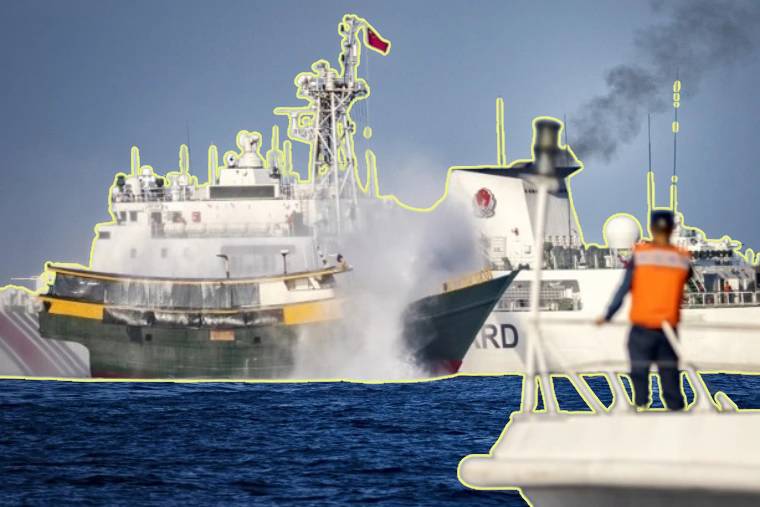|
Getting your Trinity Audio player ready...
|

- China’s territorial claims in the South China Sea, combined with other maritime features like Ayungin Shoal which are well within the Philippines’ exclusive economic zone, have caused both countries to be entangled in a prolonged territorial dispute.
- Philippine Coast Guard accuses China of taking “dangerous and blocking” actions while its vessels patrol close to Scarborough Shoal in the South China Sea.
- Recent Chinese actions pose a risk of escalating tensions along the disputed waterway, which China claims entirely for itself and through which most international maritime traffic flows.
- The tensions between China and the Philippines seriously undermine regional stability and any military confrontation can disrupt economic activity, and put pressure on diplomatic relations with neighbouring countries.
The highly sensitive South China Sea is becoming a potential hotspot between Manila and Beijing due to an intensifying diplomatic spat and recent maritime disputes. A Chinese statement claiming that the two countries had resolved their escalating maritime confrontation in the South China Sea was denied by the Philippines on April 27, 2024, which dismissed it as propaganda. Before this, on April 18, an official from the Chinese embassy in Manila asserted without offering any additional information that the two countries had earlier in the year decided on a “new model” for handling tensions at the Second Thomas Shoal.
Historic Animosity
The origin of these growing tensions can be traced back to the Mischief Reef event. Chinese troops seized control of the Mischief Reef in 1995, despite the Philippines’ claim. On Mischief Reef, China has stationed military equipment. On the basis that the ship’s bottom was leaking and it had to land on the reef, the Philippines Navy then proceeded to sail its tank-landing ship, BRP Sierra Madre, to the Second Thomas Shoal in 1999. The Philippines has kept a marine contingent on the Shoal ever since. Additionally, diplomatic obstacles stemmed from China’s control over the situation, despite international warnings. Problems were sparked again in 2018 when reports of Chinese vessels seen in the harbour arose. The situation deteriorated even worse after a Chinese militia vessel and a Filipino fishing boat collided in the area in 2019.
Due to its strategic location, economic and military significance, and important marine routes, the Shoal has been at the core of territorial disputes between the two. To facilitate strategic positioning and naval traffic surveillance, it grants the governing country jurisdiction over sea lanes. Its abundant marine biodiversity and use as a fishing ground by nearby people also contribute to the area’s economic significance. Fishermen from different countries come to fish around the shoal because of the rich fisheries. Additionally, it provides a strategic advantage in military operations by giving one a point of view to watch and possibly influence air and naval actions in the region.
Recent Developments
Following a year of heated ship-to-ship encounters in the South China Sea that raised concerns about armed involvement in the region, China and the Philippines announced in January 2024 that they had decided to work on reducing tensions. However, in February, hostilities flared up again as the Philippine Coast Guard accused China of taking “dangerous and blocking” actions during the month while its vessel was patrolling close to Scarborough Shoal in the South China Sea. The situation worsened in March when the Philippines accused China’s coast guard of “reckless” and “illegal” actions that resulted in a collision between a Philippine ship and a Chinese ship, damaging the latter and hurting a number of its personnel, while the troops were being resupplied at the Second Thomas Shoal. On the other hand, China claims that the Philippine vessels entered the waters next to the shoal without authorization.
On April 27, the Philippines refuted a Chinese claim that it accomplished a settlement with the Philippines over a growing territorial conflict in the South China Sea, referring to the claim as propaganda. Secretary of Defence for the Philippines Gilberto Teodoro stated that since President Ferdinand Marcos Jr. assumed office in 2022, his department is “not aware of, nor is it a party to, any internal agreement with China.” Following this, Manila protested Beijing’s use of water cannons against its warships in the disputed Scarborough Shoal a few days later by summoning the Chinese embassy’s number two official. The Philippine Coast Guard (PCG) vessel and the Bureau of Fisheries and Aquatic Resources (BFAR) boat were damaged on April 30 near the China-controlled Scarborough Shoal.
In response to the Philippines, China has disclosed to the public for the first time what it claims to be an unwritten 2016 agreement with the Philippines about access to the South China Sea islands. According to a statement from the Chinese Embassy in Manila, China had to take action because the Philippines had been adhering to the agreement for the previous seven years but had recently broken it to “fulfil its political agenda.” The action poses a risk of escalating tensions along the disputed waterway, which China claims almost entirely and through which most international traffic flows.
Conclusion
China’s territorial claims in the South China Sea, combined with other maritime features like Ayungin Shoal which are well within the Philippines’ exclusive economic zone, have caused both countries to be entangled in a prolonged territorial dispute. Given the growing possibility of a military confrontation, disruption of economic activity, and pressure on diplomatic relations with neighbouring countries, the tension between China and the Philippines over the South China Sea seriously undermines regional stability. To prevent tensions from getting worse and to promote peace and stability in the area, efforts must be made to resolve them diplomatically and through multilateral discussions.
(Anjali Singh is a Postgraduate student in political science and international relations. She has interned with the Indian Council of World Affairs, New Delhi, as a Research Intern. Views expressed are the author’s own)
